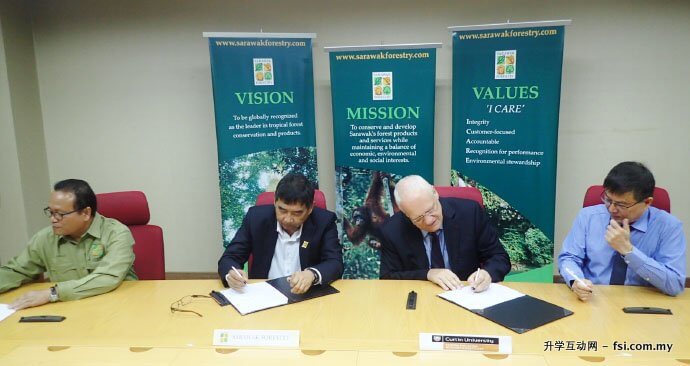Miri – 8 June 2010 – The inhabitants of Long Makabar in Upper Baram have Project Care to thank for helping them harness solar energy to light up their cultural centre and hopefully create a much brighter future for their rural community.
Project Care is the community outreach programme of Curtin University of Technology, Sarawak Malaysia (Curtin Sarawak)’s John Curtin Leadership Academy (JCLA), an elite leadership programme developed in honour of John Curtin, the fourteenth premier of Australia after whom the university is named, with the objectives of instilling in student leaders Curtin’s three core values of vision, leadership and community service.
Under a RM20,000 Solar Panel Project that took the Project Care team comprising eight caring JCLA students almost two years to fund and implement, solar panels were installed at Long Makabar’s cultural centre by the students from 29 March to 1 April 2010.
The students are Johan Iskandar, Kairul Azhar, Suhas Tadas, Shahul Hameed, Gerain Chan, Karen Kuek, Catherine Chia and Wong Mingyi. Interestingly, their backgrounds are quite varied but it was no obstacle for them to work as a team. Johan is from Seremban, Shahul from Penang, Kairul and Chia from Selangor, Wong (currently studying at Curtin Perth) from Seremban, Chan is from Sabah, Suhas from India, and Kuek from Kuching.
To raise funds for the project, a number of fund-raising events were organised beginning in August 2008. This included a fund-raising concert by students in October 2009, which attracted an audience of over 500 and raised some RM6,000 for the cause – the largest collection from a single event. Corporate sponsors including Sarawak Shell, Samling Corporation and Miri Printing also came forward with financial and logistics support.
Through their untiring efforts and support from others, the team realised their dream when they finally got to install the solar panels which generated about 400 watts of electricity.
Furthermore, they have not only embarked on a noble project but have also introduced the idea of green technology to the Long Makabar community. The village has no permanent electricity supply and is looking at solar energy as a source of long-term affordable and sustainable energy.
According to Mingyi, who is currently studying at Curtin’s main campus in Perth, it was decided that the community’s cultural centre should be the first to benefit from this technology as it is the hub of Long Makabar’s fledgling eco-tourism and cottage industries, which the villagers are developing as added sources of income for the community.
Agriculture and fishing have been the villagers’ traditional sources of income. The men of Long Makabar usually venture out to gather wild plants, hunt and plant hill paddy while the women make handicrafts and weave.
While Long Makabar is rich in culture and natural resources, lack of electricity and easy access are setbacks to its development, and some of the breadwinners of the village have in the past found it necessary to venture to Miri City to earn a living, she said.
She added that Long Makabar does indeed have significant tourism potential, which the villagers themselves are well aware of. It is also hoped that the solar panel project will serve as a catalyst for the community’s future development in this regard.
Long Makabar is a 40-door longhouse community with about 200 inhabitants, mostly Kenyah and Penan families. It is located about 200km from Miri and currently accessible by only timber roads and via express boat plying the Baram River.
Located on the Silat River, Long Makabar is a connecting point between the upstream community of Long Banga and the downstream community of Long San. Given its strategic location, it is expected to be the centre for tourism for the communities in Kedaya Telang Usan (Ulu Baram).
It is also located near the Usun Apau National Park which features abundant wildlife, jungle streams, waterfalls, and other natural attractions. In addition, the park has outstanding regional conservation significance with its thick forest and wide range of tree species, ideal for botanists and researchers.
Visitors to Long Makabar can stay at the cultural centre which provides sleeping, shower and kitchen facilities. A sundry shop can also be found in the village. Moreover, the villagers can arrange trips to nearby waterfalls for picnics, fishing and other leisure activities.
“We can’t believe that we finally did it. It still has not sunk in,” said Johan, who is currently taking a degree in petroleum geology.
When asked how they came up with the idea, Johan said in mid-2008 when they were drafted into the inaugural John Curtin Leadership Academy, they attended an introductory workshop where they met Mercy Malaysia East Malaysia head Benjamin Chai. He inspired them to do a community project for a rural community and recommended Long Makabar for their pilot project.
Johan said they did their initial recce work and discovered that electricity was high on the wish list of Long Makabar’s people.
“Though Long Makabar is blessed with river rapids, solar power was deemed the most reliable and cost-efficient system to implement,” said Kairul, adding that the solar system was less complicated than a hydro-electric system.
Nevertheless, Johan said they consulted with experts on the proposed solar panel project on its viability and costing. After consultation, they decided to install four solar panels with a capacity of 80watts each.
He noted that the end result of seeing how happy the people of Long Makabar were was worth all the effort they put into the project.
For more information on Project Care’s Solar Panel Project at Long Makabar, visit www.doiop.com/projectcare. More information on Curtin Sarawak can be obtained from its website at www.curtin.edu.my.












Solar System and Solar Engery System
We, CIE group, offer a large selection of solar systems at the lowest prices with high quality in the world. We will beat any internationally advertised for solar systems made in China.